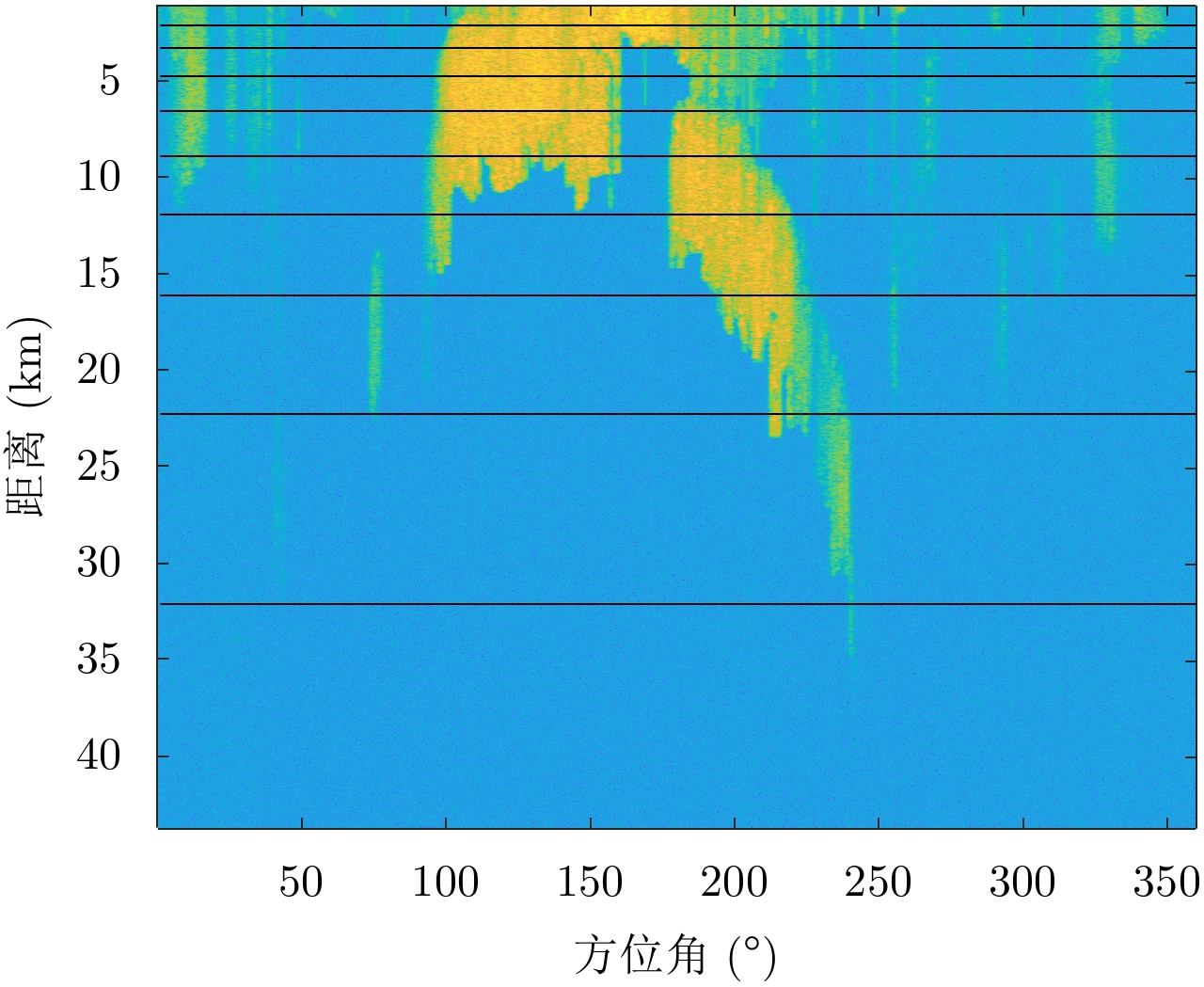- Home
- Articles & Issues
-
Data
- Dataset of Radar Detecting Sea
- SAR Dataset
- SARGroundObjectsTypes
- SARMV3D
- AIRSAT Constellation SAR Land Cover Classification Dataset
- 3DRIED
- UWB-HA4D
- LLS-LFMCWR
- FAIR-CSAR
- MSAR
- SDD-SAR
- FUSAR
- SpaceborneSAR3Dimaging
- Sea-land Segmentation
- SAR Multi-domain Ship Detection Dataset
- SAR-Airport
- Hilly and mountainous farmland time-series SAR and ground quadrat dataset
- SAR images for interference detection and suppression
- HP-SAR Evaluation & Analytical Dataset
- GDHuiYan-ATRNet
- Multi-System Maritime Low Observable Target Dataset
- DatasetinthePaper
- DatasetintheCompetition
- Report
- Course
- About
- Publish
- Editorial Board
- Chinese
| Citation: | |
Land-sea Separation and Sea Surface Zoning Algorithms for Sea Surface Target
DOI: 10.12000/JR19036 CSTR: 32380.14.JR19036
More Information-
Abstract
Adaptive detection can effectively improve the detection performance of marine surveillance radars; however, the islands or lands introduce discrete or flaky strong clutter, which may result in wrong covariance matrix estimation. Meanwhile, the complexity of the sea clutter complicates the use of a single model to describe the whole sea clutter. To solve the problem of serious degradation of clutter suppression performance when non-uniform samples participate in covariance matrix estimation and inaccuracy of sea clutter modeling, a land-sea separation and sea surface zoning algorithms are proposed for sea surface target detection. First, the land clutter and sea clutter are distinguished according to the characteristics that the phases of land echo sequences are strongly correlated while the phases of ocean echo sequences are random. Second, the sea surface is zoned according to the rubbing angle; further, the optimal distribution suited for each sea clutter zone is fitted and the appropriate adaptive detection method is selected according to the clutter distribution. Finally, the proposed algorithm is validated based on the measured data of an S-band radar. The results show that the proposed algorithm can effectively improve the detection performance of sea surface targets compared with the traditional detection algorithm. -

-
References
[1] 何友, 黄勇, 关键, 等. 海杂波中的雷达目标检测技术综述[J]. 现代雷达, 2014, 36(12): 1–9. doi: 10.3969/j.issn.1004-7859.2014.12.001HE You, HUANG Yong, GUAN Jian, et al. An overview on radar target detection in sea clutter[J]. Modern Radar, 2014, 36(12): 1–9. doi: 10.3969/j.issn.1004-7859.2014.12.001[2] 刘思彤, 程红, 孙文邦, 等. 面向海上目标的海陆分离方法研究[J]. 电子设计工程, 2014, 22(15): 96–100. doi: 10.3969/j.issn.1674-6236.2014.15.031LIU Sitong, CHENG Hong, SUN Wenbang, et al. Studies of sea-land segment methods oriented to targets on the sea[J]. Electronic Design Engineering, 2014, 22(15): 96–100. doi: 10.3969/j.issn.1674-6236.2014.15.031[3] KALKAN K, BAYRAM B, MAKTAV D, et al. Comparison of support vector machine and object based classification methods for coastline detection[J]. International Society for Photogrammetry and Remote Sensing, 2013, XL-7/W2: 125–172.[4] NIEDERMEIER A, ROMANEESSEN E, and LEHNER S. Detection of coastlines in SAR images using wavelet methods[J]. IEEE Transactions on Geoscience and Remote Sensing, 2000, 38(5): 2270–2281. doi: 10.1109/36.868884[5] LIU Chun, YANG Jian, YIN Junjun, et al. Coastline detection in SAR images using a hierarchical level set segmentation[J]. IEEE Journal of Selected Topics in Applied Earth Observations and Remote Sensing, 2016, 9(11): 4908–4920. doi: 10.1109/JSTARS.2016.2613279[6] LEE J S, JURKEVICH L, DEWAELE P, et al. Speckle filtering of synthetic aperture radar images: A review[J]. Remote Sensing Reviews, 1994, 8(4): 313–340. doi: 10.1080/02757259409532206[7] BO G, DELLEPIANE S, DE LAURENTIIS R. Semiautomatic coastline detection in remotely sensed images[C]. Proceedings of IEEE 2000 International Geoscience and Remote Sensing Symposium, Honolulu, USA, 2000.[8] 赵巨波, 符燕, 耿文东. 海杂波统计特性分析[J]. 现代雷达, 2005, 27(11): 4–6. doi: 10.3969/j.issn.1004-7859.2005.11.002ZHAO Jubo, FU Yan, and GENG Wendong. Analysis of sea clutter statistical characteristics[J]. Modern Radar, 2005, 27(11): 4–6. doi: 10.3969/j.issn.1004-7859.2005.11.002[9] 丁昊, 董云龙, 刘宁波, 等. 海杂波特性认知研究进展与展望[J]. 雷达学报, 2016, 5(5): 499–516. doi: 10.12000/JR16069DING Hao, DONG Yunlong, LIU Ningbo, et al. Overview and prospects of research on sea clutter property cognition[J]. Journal of Radars, 2016, 5(5): 499–516. doi: 10.12000/JR16069[10] KELLY E J. An adaptive detection algorithm[J]. IEEE Transactions on Aerospace and Electronic Systems, 1986, AES-22(2): 115–127. doi: 10.1109/TAES.1986.310745[11] ROBEY F C, FUHRMANN D R, KELLY E J, et al. A CFAR adaptive matched filter detector[J]. IEEE Transactions on Aerospace and Electronic Systems, 1992, 28(1): 208–216. doi: 10.1109/7.135446[12] CONTE E, LOPS M, and RICCI G. Asymptotically optimum radar detection in compound-Gaussian clutter[J]. IEEE Transactions on Aerospace and Electronic Systems, 1995, 31(2): 617–625. doi: 10.1109/7.381910[13] CONTE E, LOPS M, and RICCI G. Adaptive detection schemes in compound-Gaussian clutter[J]. IEEE Transactions on Aerospace and Electronic Systems, 1998, 34(4): 1058–1069. doi: 10.1109/7.722671[14] CONTE E, DE MAIO A, and RICCI G. Covariance matrix estimation for adaptive CFAR detection in compound-Gaussian clutter[J]. IEEE Transactions on Aerospace and Electronic Systems, 2002, 38(2): 415–426. doi: 10.1109/TAES.2002.1008976[15] OTSU N. A threshold selection method from gray-level histograms[J]. IEEE Transactions on Systems, Man, and Cybernetics, 1979, 9(1): 62–66. doi: 10.1109/TSMC.1979.4310076 -
Proportional views

- Figure 1. Adaptive detection process
- Figure 2. Flow chart of this paper algorithm
- Figure 3. Fitting result of radar data
- Figure 4. Radar position diagram
- Figure 5. Land-sea separation result based on the correlation of phases
- Figure 6. Sea surface zoning result according to the rubbing angle
- Figure 7. Detection performance of targets on sea surface


 Submit Manuscript
Submit Manuscript Peer Review
Peer Review Editor Work
Editor Work





 DownLoad:
DownLoad:





